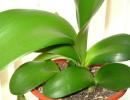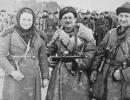Nekrasov's plan. Biography of Nekrasov: the life path and work of the great national poet. Theme of people's suffering
Nekrasov Nikolai Alekseevich was born on December 28, 1821 in the quiet town of Podolsk province Nemirovo, where that year the regiment in which his father, Aleksey Sergeevich Nekrasov, who came from a family of small landed nobles, served was temporarily stationed.
His childhood years were spent in the village of Greshnev, on the family estate of his father, a man of a despotic character who oppressed not only the serfs, but also his family, which the future poet witnessed. Perhaps this is why in Nekrasov’s works one can discern notes of pity for his own mother. The poet's mother, an educated woman, was his first teacher; she instilled in him a love of literature and the Russian language.
2. Youth
In 1832 - 1837 Nekrasov studied at the Yaroslavl gymnasium. Then he began to write poetry.
At the age of 17 he moved to St. Petersburg, but, refusing to devote himself to a military career, as his father insisted, he was deprived of material support. In 1838, against the will of his father, the future poet tries to enter the university. Having failed the entrance exams, he became a volunteer student and attended lectures at the Faculty of Philology for two years. The disasters that befell Nekrasov were subsequently reflected in his poems and the unfinished novel “The Life and Adventures of Tikhon Trostnikov.”
In order not to die of hunger, he began to write poetry commissioned by booksellers. At this time he met V. Belinsky. Soon Nekrasov’s business “went uphill”, he gives lessons, writes short articles for local newspapers, which even allows him to save money).
3. Literary and journalistic activities
Nikolai Alekseevich's affairs went so successfully that in 1847 Nekrasov and Panaev acquired the Sovremennik magazine, founded by A. S. Pushkin. The influence of the magazine grew every year, until in 1862 the government suspended its publication and then completely banned the magazine. This year Nekrasov acquired the Karabikha estate, not far from Yaroslavl, where he came every summer, spending time hunting and communicating with friends from the people.
After the closure of the Sovremennik magazine, Nekrasov acquired the right to publish Otechestvennye Zapiski, with which the last ten years of his life were associated. During these years, he worked on the poem "Who Lives Well in Rus'" (1866 - 76), wrote poems about the Decembrists and their wives ("Grandfather", 1870; "Russian Women", 1871 - 72). In addition, he created a series of satirical works, the pinnacle of which was the poem “Contemporaries” (1875).
4. Disease
But the euphoria from a good life did not last long, because already in 1850 the writer became very ill (doctors even predicted his imminent death), but the trip to Italy significantly improved Nekrasov’s health. In 1875, Nekrasov was diagnosed with intestinal cancer, after which the writer’s life turned into a slow departure to another world. It was in the period before his death that Nekrasov, having received support from loved ones, took up creativity with renewed vigor. Nikolai Alekseevich died in December 1877. The funeral of this extraordinary, but undoubtedly great personality in Russian literature, was organized by numerous fans and took place at the Novodevichy cemetery.
Left a reply Guest
Biography of Nekrasov Nikolai Alekseevich Nekrasov is a classic of Russian poetry, writer and publicist. He was a revolutionary democrat, editor and publisher of the Sovremennik magazine and editor of the Otechestvennye Zapiski magazine. One of the most important and famous works of the writer is the poem “Who Lives Well in Rus'.”
Early years Nikolai Alekseevich Nekrasov was born on November 28, 1821 in the city of Nemirov, Podolsk province, into a wealthy landowner family. The writer spent his childhood years in the Yaroslavl province, the village of Greshnevo, on a family estate. The family was large - the future poet had 13 sisters and brothers. At the age of 11, he entered the gymnasium, where he studied until the 5th grade. Young Nekrasov’s studies were not going well. It was during this period that Nekrasov began to write his first satirical poems and write them down in a notebook.
Education and the beginning of his creative career The poet’s father was cruel and despotic. He deprived Nekrasov of financial assistance when he did not want to enlist in military service. In 1838, Nekrasov’s biography included a move to St. Petersburg, where he entered the university as a volunteer student at the Faculty of Philology. In order not to die of hunger, experiencing a great need for money, he finds part-time work, gives lessons and writes poetry to order. During this period, he met the critic Belinsky, who would later have a strong ideological influence on the writer. At the age of 26, Nekrasov, together with the writer Panaev, bought the Sovremennik magazine. The magazine quickly became popular and had significant influence in society. In 1862, the government banned its publication.
Literary activity Having accumulated enough funds, Nekrasov published his debut collection of poems, “Dreams and Sounds,” which failed. Vasily Zhukovsky advised that most of the poems in this collection should be published without the name of the author. After this, Nikolai Nekrasov decides to move away from poetry and engage in prose, writing novellas and short stories. The writer is also engaged in the publication of some almanacs, in one of which Fyodor Dostoevsky made his debut. The most successful almanac was the Petersburg Collection. In 1847 - 1866 he was the publisher and editor of the Sovremennik magazine, which employed the best writers of that time. The magazine was a hotbed of revolutionary democracy. While working at Sovremennik, Nekrasov published several collections of his poems. His works “Peasant Children” and “Peddlers” brought him wide fame. On the pages of the Sovremennik magazine, such talents as Ivan Turgenev, Ivan Goncharov, Alexander Herzen, Dmitry Grigorovich and others were discovered. The already famous Alexander Ostrovsky, Mikhail Saltykov-Shchedrin, Gleb Uspensky were published in it. Thanks to Nikolai Nekrasov and his magazine, Russian literature learned the names of Fyodor Dostoevsky and Leo Tolstoy.In the 1840s, Nekrasov collaborated with the magazine Otechestvennye zapiski, and in 1868, after the closure of the Sovremennik magazine, he leased it from the publisher Kraevsky. The last ten years of the writer’s life were associated with this magazine. At this time, Nekrasov wrote the epic poem “Who Lives Well in Rus'”, as well as “Russian Women”, “Grandfather” - poems about the Decembrists and their wives, and some other satirical works, the pinnacle of which was the poem “Contemporaries”. Nekrasov wrote about the suffering and grief of the Russian people, about the difficult life of the peasantry. He also introduced a lot of new things into Russian literature, in particular, he used simple Russian colloquial speech in his works. This undoubtedly showed the richness of the Russian language, which came from the people. In his poems, he first began to combine satire, lyricism and elegiac motifs. Briefly speaking, the poet’s work made an invaluable contribution to the development of Russian classical poetry and literature in general.
Personal life The poet had several love affairs in his life: with the owner of the literary salon Avdotya Panaeva, the Frenchwoman Selina Lefren, the village girl Fyokla Viktorova. One of the most beautiful women in St. Petersburg and the wife of the writer Ivan Panaev - Avdotya Panaeva - was liked by many men, and the young Nekrasov had to put in a lot efforts to win her attention. Finally, they confess their love to each other and begin to live together. After the early death of their common son, Avdotya leaves Nekrasov. And he leaves for Paris with the French theater actress Selina Lefren, whom he had known since 1863. She remains in Paris, and Nekrasov returns to Russia. However, their romance continues at a distance. Later, he meets a simple and uneducated girl from the village, Thekla, with whom they later got married. Nekrasov had many affairs, but the main woman in Nikolai Nekrasov’s biography was not his legal wife, but Avdotya Yakovlevna Panaeva, whom he loved all his life.
Born November 28 (December 10) 1821. in Ukraine in the town of Nemirov, Podolsk province, in the noble family of retired lieutenant Alexei Sergeevich and Elena Andreevna Nekrasov.
1824–1832– life in the village of Greshnevo, Yaroslavl province
1838- leaves his father’s estate Greshnevo in order to, by his will, enter the St. Petersburg noble regiment, but, contrary to his wishes, decides to enter St. Petersburg University. His father deprives him of his livelihood.
1840- the first imitative collection of poems "Dreams and Sounds".
1843– acquaintance with V. G. Belinsky.
1845- poem "On the Road". Enthusiastic review by V.G. Belinsky.
1845–1846– publisher of two collections of writers of the natural school – “Physiology of St. Petersburg” and “Petersburg Collection”.
1847–1865– editor and publisher of the Sovremennik magazine.
1853– cycle “Last Elegies”.
1856– the first collection of “Poems by N. Nekrasov”.
1861- poem "Peddlers". Publication of the second edition of "Poems by N. Nekrasov".
1862– poem “Knight for an Hour”, poems “Green Noise”, “Village suffering is in full swing”.
Acquisition of the Karabikha estate near Yaroslavl.
1868– publication of the first issue of N.A. Nekrasov’s new magazine “Notes of the Fatherland” with the poem “Who Lives Well in Rus'.”
1868 –1877– together with M.E. Saltykov-Shchedrin, edits the journal “Domestic Notes”.
1869
- appearance in No. 1 and No. 2 of "Notes of the Fatherland" of the "Prologue" and the first three chapters of "Who Lives Well in Rus'."
Second trip abroad. Involving V. A. Zaitsev in cooperation with Otechestvennye zapiski.
1870
- rapprochement with Fekla Anisimovna Viktorova, the future wife of the poet (Zina).
In No. 2 of "Notes of the Fatherland" chapters IV and V of the poem "Who Lives Well in Rus'" are published, and in No. 9 - the poem "Grandfather" with a dedication to Zinaida Nikolaevna.
1875 – election of Nekrasov as a fellow chairman of the Literary Fund. Work on the poem "Contemporaries", the appearance of the first part ("Anniversaries and Triumphants") in No. 8 of "Notes of the Fatherland". The beginning of the last illness.
1876
– work on the fourth part of the poem “Who Lives Well in Rus'”.
Poems “To the Sowers”, “Prayer”, “Soon I will become prey to decay”, “Zine”.
1877
– at the beginning of April – the book “Last Songs” will be published.
April 4 – wedding at home with Zinaida Nikolaevna.
April 12 – surgery.
Beginning of June - meeting with Turgenev.
In August - a farewell letter from Chernyshevsky.
December – last poems (“Oh, Muse! I’m at the door of the coffin”).
Died December 27, 1877 (January 8 1878- according to the new style) in St. Petersburg. He was buried in the cemetery of the Novodevichy Convent.
Plan for the biography of Nekrasov
- 1.When I gave birth
2.What did you write?
3.His parents
4. How and why he died
And it’s all so simple for everyone! - 1. Childhood
2. Youth
4. Disease - 1. Childhood
Nekrasov Nikolai Alekseevich was born on December 28, 1821 in the quiet town of Podolsk province Nemirovo, where that year the regiment in which his father, Aleksey Sergeevich Nekrasov, who came from a family of small landed nobles, served was temporarily stationed.
His childhood years were spent in the village of Greshnev, on the family estate of his father, a man of a despotic character who oppressed not only the serfs, but also his family, which the future poet witnessed. Perhaps this is why in Nekrasov’s works one can discern notes of pity for his own mother. The poet's mother, an educated woman, was his first teacher; she instilled in him a love of literature and the Russian language.
2. Youth
In 1832-1837 Nekrasov studied at the Yaroslavl gymnasium. Then he began to write poetry.
At the age of 17 he moved to St. Petersburg, but, refusing to devote himself to a military career, as his father insisted, he was deprived of material support. In 1838, against the will of his father, the future poet tries to enter the university. Having failed the entrance exams, he became a volunteer student and attended lectures at the Faculty of Philology for two years. The disasters that befell Nekrasov were subsequently reflected in his poems and the unfinished novel “The Life and Adventures of Tikhon Trostnikov.”
In order not to die of hunger, he began to write poetry commissioned by booksellers. At this time he met V. Belinsky. Soon Nekrasov’s business took off, he gives lessons, writes small articles for local newspapers, which even allows him to save money).
3. Literary and journalistic activities
Nikolai Alekseevich's affairs went so successfully that in 1847 Nekrasov and Panaev acquired the Sovremennik magazine, founded by A. S. Pushkin. The influence of the magazine grew every year, until in 1862 the government suspended its publication and then completely banned the magazine. This year Nekrasov acquired the Karabikha estate, not far from Yaroslavl, where he came every summer, spending time hunting and communicating with friends from the people.
After the closure of the Sovremennik magazine, Nekrasov acquired the right to publish Otechestvennye Zapiski, with which the last ten years of his life were associated. During these years he worked on the poem “Who Lives Well in Rus'” (1866-76), wrote poems about the Decembrists and their wives (“Grandfather”, 1870; “Russian Women”, 1871-72). In addition, he created a series of satirical works, the pinnacle of which was the poem “Contemporaries” (1875).
4. Disease
But the euphoria from a good life did not last long, because already in 1850 the writer became very ill (doctors even predicted his imminent death), but the trip to Italy significantly improved Nekrasov’s health. In 1875, Nekrasov was diagnosed with intestinal cancer, after which the writer’s life turned into a slow departure to another world. It was in the period before his death that Nekrasov, having received support from loved ones, took up creativity with renewed vigor. Nikolai Alekseevich died in December 1877. The funeral of this extraordinary, but undoubtedly great personality in Russian literature, was organized by numerous fans and took place at the Novodevichy cemetery - That's right, nata. sha
I copied. Thank you! - 1. Childhood
Nekrasov Nikolai Alekseevich was born on December 28, 1821 in the quiet town of Podolsk province Nemirovo, where that year the regiment in which his father, Aleksey Sergeevich Nekrasov, who came from a family of small landed nobles, served was temporarily stationed.
His childhood years were spent in the village of Greshnev, on the family estate of his father, a man of a despotic character who oppressed not only the serfs, but also his family, which the future poet witnessed. Perhaps this is why in Nekrasov’s works one can discern notes of pity for his own mother. The poet's mother, an educated woman, was his first teacher; she instilled in him a love of literature and the Russian language.
2. Youth
In 1832-1837 Nekrasov studied at the Yaroslavl gymnasium. Then he began to write poetry.
At the age of 17 he moved to St. Petersburg, but, refusing to devote himself to a military career, as his father insisted, he was deprived of material support. In 1838, against the will of his father, the future poet tries to enter the university. Having failed the entrance exams, he became a volunteer student and attended lectures at the Faculty of Philology for two years. The disasters that befell Nekrasov were subsequently reflected in his poems and the unfinished novel “The Life and Adventures of Tikhon Trostnikov.”
In order not to die of hunger, he began to write poetry commissioned by booksellers. At this time he met V. Belinsky. Soon Nekrasov’s business took off, he gives lessons, writes small articles for local newspapers, which even allows him to save money).
3. Literary and journalistic activities
Nikolai Alekseevich's affairs went so successfully that in 1847 Nekrasov and Panaev acquired the Sovremennik magazine, founded by A. S. Pushkin. The influence of the magazine grew every year, until in 1862 the government suspended its publication and then completely banned the magazine. This year Nekrasov acquired the Karabikha estate, not far from Yaroslavl, where he came every summer, spending time hunting and communicating with friends from the people.
After the closure of the Sovremennik magazine, Nekrasov acquired the right to publish Otechestvennye Zapiski, with which the last ten years of his life were associated. During these years he worked on the poem “Who Lives Well in Rus'” (1866-76), wrote poems about the Decembrists and their wives (“Grandfather”, 1870; “Russian Women”, 1871-72). In addition, he created a series of satirical works, the pinnacle of which was the poem “Contemporaries” (1875).
4. Disease
But the euphoria from a good life did not last long, because already in 1850 the writer became very ill (doctors even predicted his imminent death), but the trip to Italy significantly improved Nekrasov’s health. In 1875, Nekrasov was diagnosed with intestinal cancer, after which the writer’s life turned into a slow departure to another world. It was in the period before his death that Nekrasov, having received support from loved ones, took up creativity with renewed vigor. Nikolai Alekseevich died in December 1877. The funeral of this extraordinary, but undoubtedly great personality in Russian literature, was organized by numerous fans and took place at the Novodevichy cemetery. - Nekrasov Nikolai Alekseevich was born on December 28, 1821 in the quiet town of Podolsk province Nemirovo, where that year the regiment in which his father, Aleksey Sergeevich Nekrasov, who came from a family of small landed nobles, served was temporarily stationed.
His childhood years were spent in the village of Greshnev, on the family estate of his father, a man of a despotic character who oppressed not only the serfs, but also his family, which the future poet witnessed. Perhaps this is why in Nekrasov’s works one can discern notes of pity for his own mother. The poet's mother, an educated woman, was his first teacher; she instilled in him a love of literature and the Russian language.
2. Youth
In 1832-1837 Nekrasov studied at the Yaroslavl gymnasium. Then he began to write poetry.
At the age of 17 he moved to St. Petersburg, but, refusing to devote himself to a military career, as his father insisted, he was deprived of material support. In 1838, against the will of his father, the future poet tries to enter the university. Having failed the entrance exams, he became a volunteer student and attended lectures at the Faculty of Philology for two years. The disasters that befell Nekrasov were subsequently reflected in his poems and the unfinished novel “The Life and Adventures of Tikhon Trostnikov.”
In order not to die of hunger, he began to write poetry commissioned by booksellers. At this time he met V. Belinsky. Soon Nekrasov’s business took off, he gives lessons, writes small articles for local newspapers, which even allows him to save money).
3. Literary and journalistic activities
Nikolai Alekseevich's affairs went so successfully that in 1847 Nekrasov and Panaev acquired the Sovremennik magazine, founded by A. S. Pushkin. The influence of the magazine grew every year, until in 1862 the government suspended its publication and then completely banned the magazine. This year Nekrasov acquired the Karabikha estate, not far from Yaroslavl, where he came every summer, spending time hunting and communicating with friends from the people.
After the closure of the Sovremennik magazine, Nekrasov acquired the right to publish Otechestvennye Zapiski, with which the last ten years of his life were associated. During these years he worked on the poem “Who Lives Well in Rus'” (1866-76), wrote poems about the Decembrists and their wives (“Grandfather”, 1870; “Russian Women”, 1871-72). In addition, he created a series of satirical works, the pinnacle of which was the poem “Contemporaries” (1875).
4. Disease
But the euphoria from a good life did not last long, because already in 1850 the writer became very ill (doctors even predicted his imminent death), but the trip to Italy significantly improved Nekrasov’s health. In 1875, Nekrasov was diagnosed with intestinal cancer, after which the writer’s life turned into a slow departure to another world. It was in the period before his death that Nekrasov, having received support from loved ones, took up creativity with renewed vigor. Nikolai Alekseevich died in December 1877. The funeral of this extraordinary, but undoubtedly great personality in Russian literature, was organized by numerous fans and took place at the Novodevichy cemetery.
At the turn of the 1830-1840s, a change of literary eras took place in Russian literature: after the deaths of Pushkin and Lermontov, Russian poetry entered a new era of development, and the poetry of Tyutchev, Nekrasov, Fet and a large group of new poets came to the fore. Of course, these changes do not occur because new poets simply took the place of their great predecessors - a different socio-historical time has come, which needed its own poetry. The need for artistic comprehension of the new position of man in the world and society was manifested in Tyutchev’s philosophical poetry; personal life, experiences of nature and love became the content of Fet’s lyrics. From the very beginning of his work, Nekrasov in his lyrics focused on social issues, and civic pathos became the ideological dominant of his poetry.
The social orientation of Nekrasov’s lyrics, the severity of its social themes, and sympathy for the Russian disadvantaged people were predetermined by the poet’s very life. Nekrasov spent his childhood in the village of Greshnevo, Yaroslavl province, on the estate of his father, a poor nobleman, retired lieutenant Alexei Sergeevich Nekrasov. The love and bright memories of his mother, Elena Andreevna, which the poet carried throughout his life, were reflected in his work with soulful attention to women’s plight. Even from childhood, Nekrasov recognized the need, and since his father, who served as a police officer, often took the boy with him when traveling on business, he more than once witnessed human misfortunes.
At the age of seventeen, Nekrasov, following the will of his father, went to St. Petersburg to take up military service, but soon disobeyed and, despite the threat of losing material support, preferred literary activity. Nekrasov became a volunteer student at the Faculty of Philology of St. Petersburg University and at the same time looked for ways to earn a living. Nekrasov recalled that time of his life as the most difficult - it was a time of malnutrition, constant need and concern for the future. Nekrasov was greatly helped by his rapprochement with V.G. Belinsky. He became a permanent member of Belinsky's literary circle and began collaborating in the journal Otechestvennye zapiski. In the 1840s, Nekrasov, being an energetic, enterprising and talented person, was already familiar with the entire literary society of St. Petersburg. Among his friends and good acquaintances were I.S. Turgenev, F.M. Dostoevsky, D.V. Grigorovich, V.I. Dahl, M.E. Saltykov-Shchedrin, I.I. Panaev and many other writers. The rapidity of Nekrasov’s success is evidenced by the fact that already in 1846, together with I.I. Panaev, he bought the famous, organized by A.S. Pushkin magazine "Contemporary". Under the new leadership, the magazine became the center of literary life in St. Petersburg. Belinsky, and later N.G. also played a significant role in the development of Sovremennik. Chernyshevsky and N.A. Dobrolyubov.
Nekrasov's creative and social activities were embodied in his literary works, journalism and publishing work. The magazines Sovremennik and Otechestvennye zapiski, published by Nekrasov for thirty years, are of great public importance, since thanks to them Russian society became acquainted with the best modern works and learned about new writers and critics.
However, Nekrasov's true calling was poetry. At the age of twenty, he wrote his first collection of poems, “Dreams and Sounds.” The poems in this collection are still immature, imitative, they lack independence, their own poetic voice. Nekrasov was so dissatisfied with his collection that he later even destroyed the published copies. In the early years of his work, Nekrasov had a period when he tried to write prose, but these attempts were unsuccessful. Nekrasov had to find his theme in poetry so that his poetic talent could fully manifest itself.
The themes of Nekrasov's poetry turned out to be very broad and versatile. At first, the image of human suffering in a big city, love lyrics, and elegies prevailed. Later, the poet's civil lyrics cover deeper themes; they address the life of the people, especially the peasantry, and current social issues. These are the poems “The Uncompressed Strip” (1854), “Schoolboy” (1856), “Reflections at the Main Entrance” (1858), “The Railway” (1864). The poet’s social position was clearly manifested in poems written on the death of his colleagues in activity: “In Memory of Belinsky” (1853), “In Memory of Shevchenko” (1861), “In Memory of Dobrolyubov” (1864). The theme of the poet and poetry occupied a special place in Nekrasov’s work, and it was most clearly manifested in the poem “Elegy” (“Let changing fashion speak to us...”, 1874). Deep tenderness is heard in Nekrasov’s poems about children and women, such as “Song to Eremushka” (1859), “Peasant Children” (1861), “Mother” (1868). In the poems “Sasha” (1855), “Frost, Red Nose” (1862-1864), “Russian Women” (1871 - 1872), the life of Russia is shown from different sides, but the image of a Russian woman is invariably in the center: be it a woman with high aspirations, or a peasant woman with a tragic fate, or devoted wives of the Decembrists. In the last period of his creativity, Nekrasov worked on the epic poem “Who Lives Well in Rus'” (1863-1876), in which the poet created a grandiose picture of post-reform Russia, capturing all the great diversity of its life in a rich gallery of images of peasants, soldiers, artisans, and ordinary people , landowners, clergy. The poem absorbed Russian folk art: songs, legends, proverbs, fairy-tale elements. The work is dominated by the tale form of narration and Russian colloquial speech. In terms of artistic power and ideological significance, the images of Savely - the Holy Russian hero, the peasant woman Matryona and the people's intercessor Grisha Dobrosklonov are important. They embody the main idea of Nekrasov’s work, expressed in the song that concludes the poem “Who Lives Well in Rus'”:
You're miserable too
You are also abundant
You're downtrodden
You are omnipotent
Mother Rus'!..






